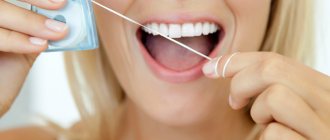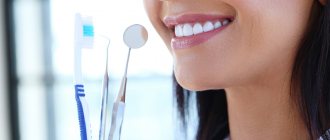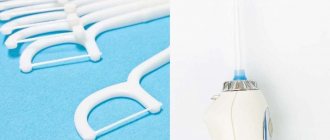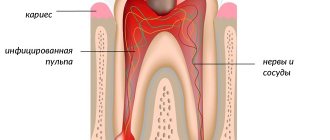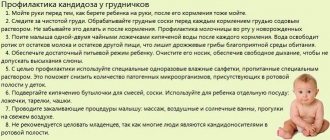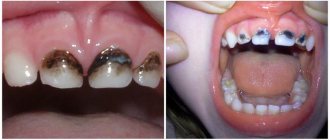Anna Andreevna Bespalova, a dentist-therapist at the Denta-El clinic, talks about what procedures are necessary to prevent and protect against oral diseases, as well as how to effectively combat diseases such as caries, stomatitis, etc.
It is common knowledge that poor oral hygiene is the root cause of all problems. However, not everyone understands why hygiene is so important. Without constant care, accumulations of plaque (at first soft) form in the mouth, becoming an ideal breeding ground for bacteria.
They digest plaque and release acids that negatively affect teeth. The layers of calcium are washed away and the enamel dissolves, becoming brittle. As a result, so-called demineralization of the enamel is observed, which ultimately leads to the formation of caries.
In childhood, this often manifests itself as white (sometimes yellow) spots on the teeth on the front side. The next stage after this is caries.
Tartar
Tartar is a soft plaque that has been in the mouth for so long that it has hardened to such an extent that it seems to “ stick ” to the tooth. At the same time, in addition to difficulties with hygiene, the stone can cause inflammation of the marginal gum - swelling and bleeding, causing constant discomfort. As a result, children try to avoid inflamed areas when brushing their teeth.
The result of this process is gingivitis and stomatitis , and in advanced cases, gum atrophy occurs along with exposure of the dental necks. The sensitivity of teeth to temperature and other influences increases significantly .
How to remove plaque
Removing soft and hard plaque from teeth seems to be an elementary procedure, but, nevertheless, it requires the specialist, in addition to attention, to have some experience in such operations . The soft coating is removed with special rubber bands (or a brush). As a rule, children do not object to this - they do not experience discomfort or pain as a result of the procedure . But the importance of such a procedure is difficult to overestimate - despite its apparent simplicity, it can become an important preparation for subsequent treatment, accustoming the child to manipulations in the oral cavity.
In the case of tartar, special devices - ultrasonic or manual.
Frequency and periodicity of professional hygiene
Of course, the frequency of professional cleaning is different for each child , and depends mainly on the quality of dental care - some children brush their teeth so well that they can only be taken to a specialist annually, while others ...
When undergoing orthodontic treatment, crowded teeth or poor hygiene, preventive maintenance and professional cleaning should be performed as often as possible .
Do not underestimate the importance of professional cleaning - after all, during it, the doctor will not only teach the child how to properly care for his teeth, but will also select individual products or medications - this is especially important for various diseases or defects of the oral cavity. For example, if there is crowding, a regular toothbrush is not very effective; in this case, the child needs a special brush.
Prerequisites for the rapid formation of plaque on children's teeth
- A small amount of solid food in the child's menu - modern children gravitate towards soft food that does not require active chewing. Even fruits and vegetables are served to children in the form of purees or finely chopped.
- A large amount of sweets in a preschooler’s diet – carbohydrate foods accelerate the growth of bacteria.
- The thin enamel of baby teeth is quickly destroyed, which contributes to the strong fixation of plaque on the teeth and the spread of the film.
- Poor daily care. Preschool children themselves do not brush their teeth well, and parents do not always remember the need to control the quality of daily hygiene.
- Frequent colds and taking antibiotics worsen the bactericidal effect of saliva, which is important for the natural removal of dental plaque.
- Lack of microelements - fluorine, calcium.
Features of professional oral hygiene
Oral hygiene in children three to five years old
- removal of plaque and plaque using rotary brushes (using low-abrasive pastes);
- floss polishing
- remineralizing therapy (local, using gels and jellies).
Oral hygiene in children six to ten years old
- determination of quality of care ( plaque markers
- regular teeth cleaning under the supervision of a specialist;
- hygiene index – the quality of the child’s teeth brushing, his mistakes;
- training in proper cleaning;
- repeated cleaning under the supervision of a specialist, taking into account her recommendations;
- removal of plaque and plaque using rotary brushes (using low-abrasive pastes);
- polishing with rubber heads and paste; strips (strips);
- remineralizing therapy (office or at home);
- local fluoridation using gels, jellies or varnishes.
Oral hygiene in adolescents aged eleven to sixteen
- removal of plaque and plaque using rotary brushes (using low-abrasive pastes and air-abrasive devices). For mineralized deposits - cleaning with ultrasonic tips ;
- periodontal soft tissue indices. If symptoms of inflammation are detected, anti-inflammatory treatment is carried out;
- remineralizing therapy (at the dentist or at home).
Fissure sealing
Fissures are grooves on the chewing surface of the tooth that separate the chewing cusps.
Most often, caries forms on fissures and interdental spaces. At 6–7 years of age, children’s permanent chewing teeth erupt, but the enamel in the fissure area has not yet fully formed. Fissures become a vulnerable place for caries. Food debris gets stuck in them and causes caries, especially carbohydrates.
To avoid this, a sealing procedure can help. Sealant is a liquid filling material. It fills all the cavities on the surface of the tooth and creates a barrier for bacteria. Sealants seal fissures, nourish the enamel with fluoride and help it form healthy.
How is fissure sealing performed?
- First, the tooth is thoroughly cleaned of plaque.
- If necessary, the doctor “opens” the fissures.
- If the fissure is deep and narrow, the doctor can widen it with the smallest bur. This way the material will be better distributed throughout the fissure.
- After preparing the tooth, the fissure is filled with sealant and illuminated with a photopolymer lamp for 40 seconds.
- The tooth is polished and coated with a protective varnish containing fluoride.
The procedure takes 30 minutes. In one visit, you can seal the fissures of all chewing teeth. Anesthesia is not needed for the procedure, because the deep tissues of the tooth are not affected.
At the Denta Vi dental clinic in Yekaterinburg, a pediatric dentist is attending.
We treat caries in children, straighten the bite and carry out caries prevention. Remember to bring your child to the doctor regularly for preventive examinations to maintain the health of his teeth and the beauty of his smile. We will advise you on the rules of caring for children's teeth and give all the necessary recommendations. Make an appointment
Basic personal hygiene mistakes
- the procedure is performed too quickly ;
- cleaning occurs before eating ;
- no intermediate hygiene during the day (after meals);
- incorrect cleaning method. It is necessary to clean your teeth from all sides;
- insufficient care for hard-to-reach places - oral care methods
- poor selection of hygiene products. They also need to be constantly replaced with new ones;
- abuse of bleaching pastes based on peroxide compounds (usually with increased abrasive properties). This leads to the spread of pathogens .
All these mistakes often result from a lack of awareness among children and parents themselves about proper oral hygiene. To avoid this, regular consultations with an orthodontist are necessary.
Treatment methods for malocclusion in children
Why correct an overbite?
The issue of correcting the bite is not only about the aesthetic component of an even smile. Dental defects associated with incorrect positioning of teeth are dangerous because they can lead to early tooth loss and digestive disorders, distort facial features and make it difficult to pronounce sounds. That is why it is important to start correcting your child’s malocclusion as early as possible.
If you and your relatives have an unusual arrangement of teeth and jaw shape, it is best if the baby is shown to a specialist pediatric dentist at the North-Eastern Dental Center even before the baby teeth erupt.
Causes of malocclusion in children:
- hereditary abnormalities that appear from birth,
- teething disorders,
- thumb sucking,
- prolonged period of pacifier sucking,
- diseases of the throat and nose suffered at an early age, since impaired nasal breathing changes the shape of the jaws and, consequently, the direction of tooth growth.
Is it possible to prevent malocclusion in children?
To prevent malocclusion in children whose teeth have not yet fully erupted, the doctor may prescribe special orthodontic pacifiers - they are designed to separate the tongue from the teeth. After the eruption of all baby teeth, the orthodontist, having discovered bite pathologies, will decide whether it is worth treating the child now or whether it is better to postpone treatment until the moment when it is possible to influence the growth of the jaws and stimulate the eruption of permanent teeth in the right direction.
If there are difficulties with chewing, the child breathes through the mouth, sucks his thumb day and night, the doctor develops a set of procedures to prevent future problems with bite.
Methods for correcting malocclusion
Basically, orthodontists work with malocclusion using orthodontic devices - a variety of plates and brace systems. Modern braces have an aesthetic appearance thanks to multi-colored materials and elegant decorations. You and your child can choose multi-colored braces or clasps, or “glowing” braces that look impressive in any nightclub.
The plates are removable devices that, if necessary, can not be worn during the daytime, but only worn at night. The effectiveness of their use is high in children under 12 years of age - while the formation of the jaw has not yet been completed.
Bracket system
is a set of many plates glued to the teeth, having grooves into which a metal arch is inserted. The arch is initially given a shape that is harmonious for a given dentition, and after being applied to the teeth, the arch begins to strive for the given shape, pulling the teeth along with it.
The duration of correction of malocclusion is about 1-2 years. When correcting a bite, it is important to remember that the sooner you take your child to the dentist, the less treatment he will need in the future.
Gum care in the first months of life
The first six months of life is the period when microbes populate the child’s mouth , which means that there is an increased likelihood of diseases - caries, stomatitis, infantile thrush, etc. Parents and other relatives often cause such diseases by transmitting germs to the baby through kisses, pacifiers, dishes and neglect to wash objects with boiled water. To minimize the risk, your child should wipe their gums with special wipes or finger tips every time after eating.
Cleaning baby teeth
Children should brush their baby teeth with a special brush for babies . At the beginning, the cleaning time should be 15-20 seconds , then the duration should be gradually increased . The most difficult thing at this moment, of course, is to arouse the child’s interest in this boring activity, from his point of view.
There are two methods as old as the world that have never lost their effectiveness:
- Turn hygiene training into a game - what little kid wouldn't love a flying spaceship brush or a superhero protecting his teeth? If the child is interested, he will voluntarily let his teeth be brushed and wait until the procedure is over. Perhaps even patiently.
- teach a child to do like mom or dad - children love to repeat after their parents. This feature can easily be used in the process of teaching children how to brush their teeth. Doing this with your child every day, you will find that your baby himself is demanding that the ritual be continued. The most important thing is that the pasta is to your taste .
It happens that toothpaste and brushes are simply not nearby, then dentists recommend chewing gum without sugar or a more traditional and healthy option - chewing an apple .
When should you start brushing your child's teeth with toothpaste?
From the age of 1 year, you can purchase special toothpastes for your baby. Parents should remember several conditions that must be met when choosing children's toothpaste:
- it should not contain fluorine;
- you need to choose a paste that can be swallowed - a small child simply does not know how to spit it out;
- the paste should not contain strong abrasive particles - they can damage the delicate enamel of the baby’s teeth;
- Children's toothpaste should not contain dyes, parabens or surfactants.
Children's toothpaste “Ushasty Nyan” from:
- the composition contains xylitol, which prevents the appearance of foci of dental caries;
- It has a pleasant taste - the baby will not have attacks of nausea, and the teeth cleaning procedure will proceed calmly;
- the structure of the paste is gel, and this ensures protection of soft tissues and insufficiently strong enamel from microtraumas;
- The composition includes aloe vera extract, which has softening and anti-inflammatory properties.
In addition, the Ushasty Nyan children's toothpaste contains no fluoride, dyes, flavors or sugar.
By the way, Nevskaya Cosmetics offers a whole line of children’s toothpastes, so you can choose this product for a child of any age.
When should you start brushing your child's teeth with toothpaste? If the baby’s development is within normal limits and the dentist allows the use of the paste, then it should be purchased for a one-year-old child. Some children are significantly ahead of their peers in development - at 9-10 months they already have many teeth, they eat at the same table with their parents. In this case, toothpaste can be purchased before the age of one, but you should first consult with a pediatric dentist.

